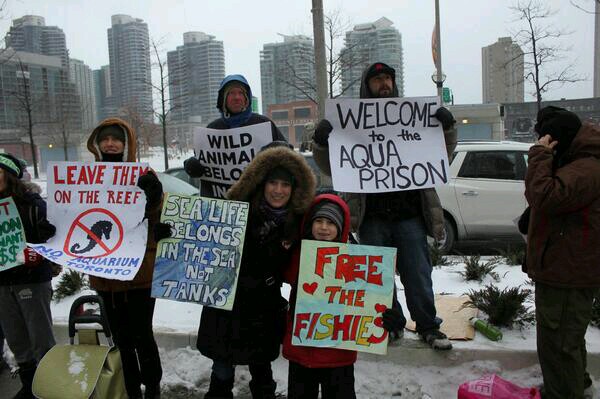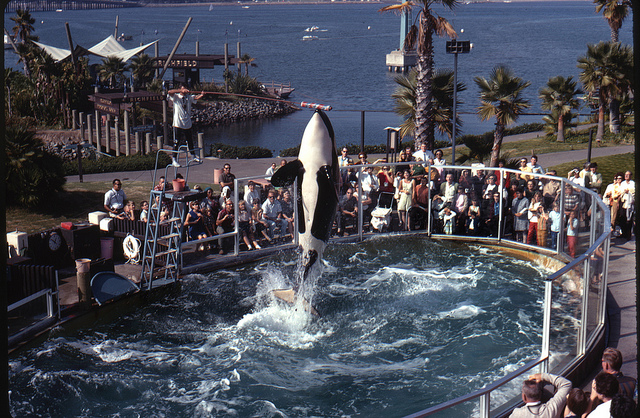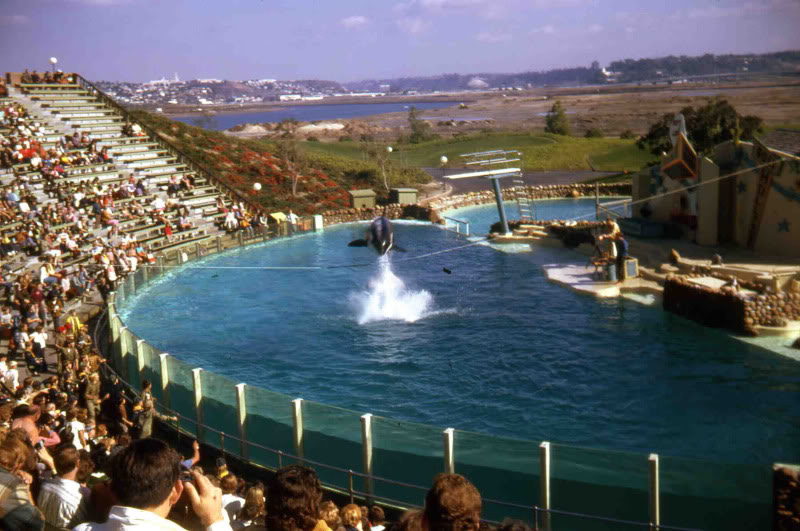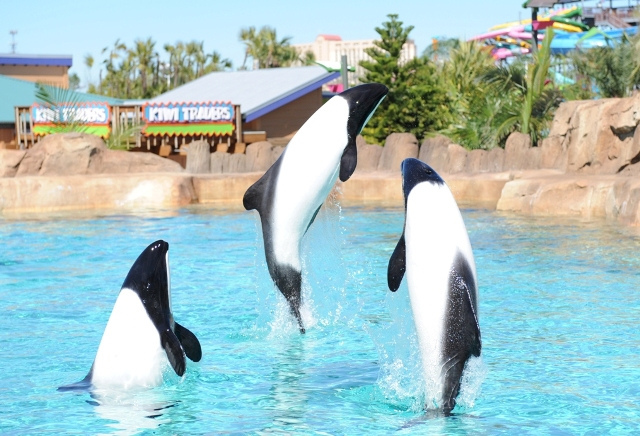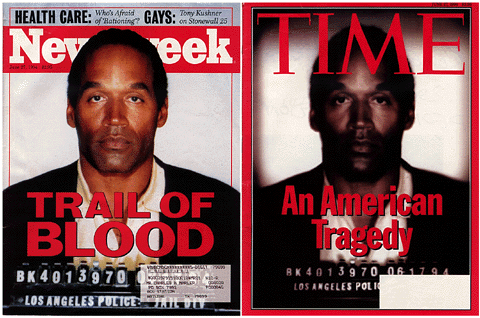“I THINK THAT WE ARE ALIENATED FROM ALL THE OTHER ANIMALS ON THE PLANET, ALL THE OTHER SPECIES. WE WILL NOT HAVE A WORLD OF LOVE AND EVEN SELF RESPECT.”
There’s a very good chance this blog post might either piss you off or make you very annoyed. It’s also pretty damn long. You’ve been warned.
I wrote a report titled “Dissecting Blackfish” which analyzed the creative edits, substituted footage, inclusions, and omissions in both Blackfish and David Kirby’s book Death at SeaWorld. What I didn’t mention is that I believe all their choices to be correct.
Let me explain. When making a film or writing a book, it is necessary for them to retain plot, pace, tone, and audience retention throughout the work. Something like Lori Marino’s involvement with the animal rights movement was not necessary to the plot. She wasn’t in the film as an animal rights activist, she was there as a neurologist. But that’s the art of making a film.
Although it’s perfectly acceptable to make those editorial choices from an artistic point of view, the extensive use of substituted footage and omitted data erodes at the film’s objectivity. While it is true that it doesn’t preach to the audience, it instead uses its imagery to create a much more visceral and primal reaction. Davis Guggenheim and Leni Riefenstahl also mastered the art of agenda driven films in slick packages. I’ve watched their films numerous times, but neither one encouraged me to become a NAZI or support charter schools. I support the fight against global warming because I took the time to research that as someone interested in my planet.
But you won’t find me protesting for the orcas to be released, even though I’ve seen the film more than fifty times and have it memorized forward and back. I support a different solution, described below, that would encompass a radical change in SeaWorld’s business model and the cooperation of the free-cetacean activists. I base this in part on a belief held by many, including Dr. John Jett of Stetson University, that the whales currently in captivity are ineligible for release to the wild. If you don’t know who Dr. Jett is, you haven’t seen Blackfish.
My biggest fear for Blackfish is that it’s a gateway drug in the quest to remove all animals from captivity. Next thing you know, Blackfish fans will be at the new Ripley’s Aquarium of Canada in Toronto to protest the “slavery” of fish.
Oh lord, it’s already happened.
For the record kid, I don’t eat fish. They’re better left in whales’ bellies.
As with the report, I’m not going to attempt to contradict the “facts” presented in the film, nor will I attempt to validate them. I’m not a cetologist, veterinarian, or marine mammal trainer. I have not worked for the current SeaWorld management and have not been to one of their parks for more than fifteen years.
The film is a perfectly constructed piece of work. But it’s also extremely one sided. Now you can argue that it’s one sided only because the other side is telling nothing but lies. I’ve heard an excuse to an issue like that before. It came from a group of Holocaust deniers. So if that’s your excuse, you’re in good company. Blackfish is just one part of a battle of propaganda between both sides of the captive orca argument, with both sides acting like the issue is black and white, when in fact it’s very complicated. It’s very much a Kramer vs Kramer scenario, but instead of a kid, there’s a bunch of performing animals stuck in the middle.
Since Blackfish first aired on TV, I’ve seen a wide variety of responses on what people think should be done.
- There are those who just don’t give a crap.
- There are those, primarily theme park fans with their propagandist websites and podcasts, that believe nobody knows these animals better than SeaWorld. I will give credit to the keepers, trainers, and veterinarians that have worked with and are currently working with SeaWorld’s animals for truly caring deeply about them and for them and for providing them with some of the best care in the zoological park industry. And I wish to clarify something here. I received some negative feedback about my report for “villainizing” Dr. Lanny Cornell. That was not my intention. I was exploring how Kirby covered him in the book. Dr. Cornell remains one of my heroes and the reason I followed my SeaWorld internship by working for a veterinarian.
- There are those that want the animals returned to the wild. As shown with Keiko, this is both a lengthy and costly proposal for orcas.
- There are those that want a sanctuary developed – a netted off cove or sea pen where the whales can continue to be cared for while experiencing an ocean environment. While also very costly, I question the validity of returning Tilikum to a sea pen when he experienced his first decade of abusive care in one at Sealand of the Pacific.
I fully respect each individual’s right to have their beliefs and to express them as they wish. Case in point – Dr. Lori Marino. I’m actually a huge admirer of her research. Dr. Marino was gracious enough to recently answer a question I had on cetacean brain development. But when it comes to what should be done with SeaWorld’s orcas, we differ and here’s why:
She believes no cetacean should be in captivity. I respect her right to that belief. But I believe that SeaWorld’s orcas are too habituated to humans. They crave the attention of park guests. So I prefer a strategy that would benefit SeaWorld, its visitors, and the animals’ welfare. Many former SeaWorld trainers that I’ve spoken to or listened to advocate this plan, at least in part.
-
- End the captive breeding. The gene pool can only go so far before defects from inbreeding start to show. Eliminate wild capture or the importation of wild caught orcas from international parks or the importation of orca sperm from donors in other parks. Essentially, the current SeaWorld populations will die out within fifty years, but it won’t spell the end of SeaWorld. The chain existed before housing captive orcas, it will exist after.
- Eliminate the choreographed shows. Keep the trainers, but instead of having them instruct the orcas to perform behaviors on cue, have them encourage the orcas to perform natural behaviors at their own whim.
- Build the orca sanctuaries within SeaWorld parks. It’s time for bigger enclosure space, perhaps with inlets the orcas can explore. It can be done. The construction techniques are there. SeaWorld should be able to get it funded. They can earn extra revenue with VIP viewing areas and a full service dining restaurant. And an attraction resulting in a big reveal, like PGAV Destinations has done with their preshow for the Space Shuttle Atlantis (see video), would give the same sense of awe as an orca jumping in a spotlight.
Is this feasible? Yes. Will it happen? Well, let’s look at business 101. If a company like SeaWorld has the ability to build these facilities, which are multi-year investments likely in the hundreds of millions of dollars, why would it expend the money to build these larger tanks for its orcas when it is continually at risk of losing them through the threat of legal action and actual lawsuits like the recent 13th Amendment suit that was filed by Peta, another one of my heroes, Ric O’Barry (shocking that I support some of what he does and also some of what SeaWorld does), Dr. Ingrid Visser and three people that appeared in the film – researcher Howard Garrett, and former trainers Samantha Berg and Carol Ray?
As much as I admire Mr. O’Barry, I feel, much like Lori Marino’s group, that this was a desperate and not well thought out attempt to free the orcas, with the result being setbacks for their improved welfare at the parks. That includes the “orca treadmill.” Contrary to what David Kirby has written, it exists. But again, why would you expend millions of dollars on this when you risk losing your animals within months of installing it?
Zoos when they started were pleasure gardens, often for royalty, featuring exotic animals captured by hunters and poachers in the far corners of the world. When the capture of orcas started in the early 1960’s, it was no better. In 1964, one of the first captives orcas, Moby Doll, was harpooned to become the model for a statue commissioned by Vancouver Aquarium owner Murray Newman. He survived for 86 days.
In 1967, this what an orca tank looked like at Sea World of California:
In 1970, they moved to this larger pool:
In 1987, this:
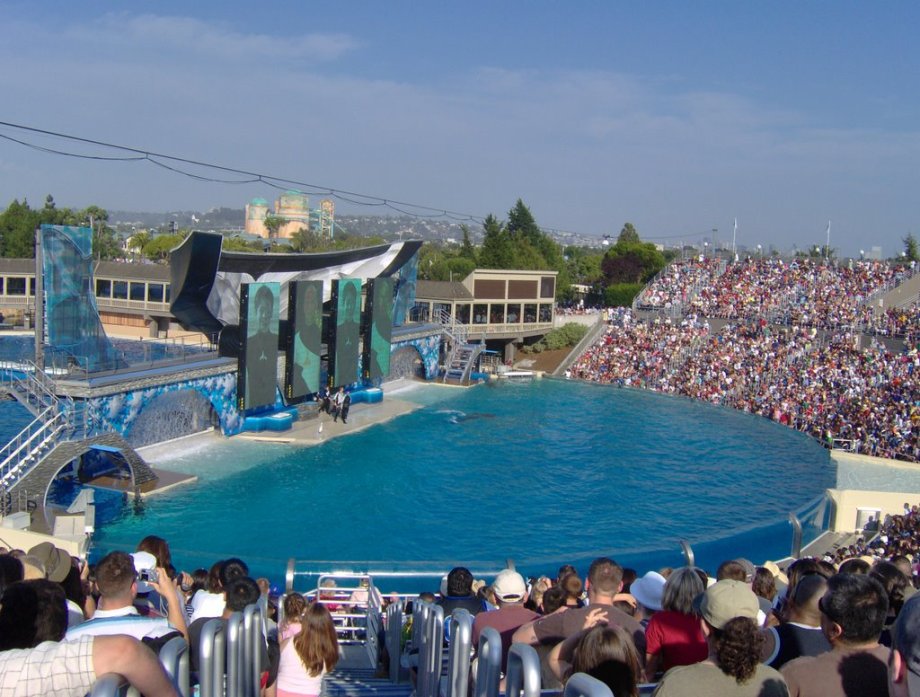 The enclosure space has not been enlarged for close to 30 years, even though more orcas are occupying it. A surface space three times as big as all the orca pools currently in San Diego would be the approximate size of the land allocated for the Manta coaster. It can be done.
The enclosure space has not been enlarged for close to 30 years, even though more orcas are occupying it. A surface space three times as big as all the orca pools currently in San Diego would be the approximate size of the land allocated for the Manta coaster. It can be done.
The one thing I’ve become more jaded about in my old age than performing sea mammals is the “Dolphin Encounter” or “Dolphin Swim” experiences. Why?
- If you want to talk about habituating animals to humans, this certainly is the way to do it.
- Dolphins by their nature are prone to aggression. It has been documented at these establishments and it will continue to happen.
- Dolphin encounters continue to be one of the fastest growing segments of the captive marine mammal industry, partially because they can be placed at any resort in a sea pen or concrete pool and partially because they don’t necessitate as much oversight as most aquariums. And the owners can charge an arm and a leg. Guess where a lot of those Taiji captures are going. Demand for new animals and locations continues to increase year after year, facilitating more captures from the wild. Now, I’m not including Discovery Cove in this as most of those dolphins were either retired to the interactive park after years in SeaWorld parks or were born into those collections. However, I am calling SeaWorld out for having Commerson’s dolphins at Aquatica. What the hell? These aren’t tropical dolphins!
- Finally, there’s the socioeconomic disparity of such attractions. Children of low socioeconomic status can’t afford such activities, either individually or within a school group. For instance Marineland of Florida in St Augustine charges $6 for children to just enter the place and look. $10 will get them a behind the scenes tour. $30 for a session to touch and feed a dolphin (the same is charged per student for school groups) and $169 for 20 minutes in the water with a dolphin. The unfortunate effect of this disparity is that these low income children are the very ones that should be given access to the dolphins in order to build an appreciation for the animals and an interest in conservation and marine sciences. Marineland of Florida is owned and operated by the Georgia Aquarium, the institution appealing a decision denying the importation of captured belugas. It also maintains a business partnership with CNN, the network that slammed SeaWorld, but crap, lesser of two evils right?
So let’s move on to the main topic at hand. I told you this would be a long post.
Just after the Oscar nominations were announced, Jeff Ventre one of the members of the Blackfish tweeted the following:
Rec’d an email: SW PR firm 42 West reportedly calling themselves “Oscar Whisperers” & claiming to have impacted vote
42 West, SeaWorld’s PR firm is indeed known as the “Oscar Whisperers” due to the number of successful Oscar campaigns the firm and its staff have managed over the years – including for No Country for Old Men, Crash, The Departed, and Hurt Locker. So one day, according to myth, SeaWorld approached their public relations people and told them about this problematic Blackfish film. The folks at 42 West sat around for a while and then implemented a very radical and controversial strategic plan.
They
Did
Nothing
And it worked. Blackfish did not get nominated for an Oscar.
The film’s director Gabriela Cowperthwaite told the LA Times, “A lot of times the documentaries that do well have a lot of original footage, and a lot of the footage in ‘Blackfish’ is archival.” The same can be said of Oscar winners The Fog of War and Man on Wire. So it had to be something else.
The first thing we need to look at is who chooses the nominated films for the Best Feature Documentary category. The Documentary Branch of the Academy is where that decision’s made. It’s chaired by Rob Epstein, two time documentary Oscar winner for The Times of Harvey Milk and Common Threads: Stories from the Quilt. And a sampling of some of the other Documentary Branch members gives us Joe Berlinger, Liz Garbus, Alex Gibney, Mark Lewis, and Julie Reichert. In other words, the people picking the nominations for the documentary Oscars are all documentarians themselves.
So I made it past the Blackfish poster with the lovely photo of Keiko the whale rehabilitating in the Oregon Coast Aquarium, darkened in the way that TIME magazine manipulated OJ Simpson’s mug shot to make it more menacing.
I saw the trailer, which is almost entirely about Dawn’s death. I heard former trainer Jeff Ventre say “They never told us.” I heard him say “I was told to throw away the tape.” I expected a film exposing a huge conspiracy of a SeaWorld cover up. I was disappointed.
So the bullshit misleading marketing aside, here’s where the film erred. There are only three sympathetic characters in the film – Dawn, Tilikum, and John Crowe. The rest leave us no room for emotional attachment. In fact, the film is so well made, so well packaged, and so streamlined that it tugs at the heartstrings not through pure emotion but rather through shock value. Blackfish comes across as a long-form episode of the Animal Planet exploitation series Animal Nightmares that both Cowperthwaite and the film’s producer Manny Oteyza were involved with. It is the complete opposite of Stanley Minasian’s anti-captivity film A Fall from Freedom.
FEAR/ANIMAL NIGHTMARES (National Geographic/Animal Planet 2001) from ASKlabs Productions on Vimeo.
An unfortunate side effect is that while people show sympathy for the bloodied and manhandled animals and for the dead trainers and the dude who learned the hard way about castration (though it wasn’t mentioned in the film), the injured trainers become nothing more than a statistic. A twitter search on “Ken Peters” and “Blackfish” did not return a single tweet concerned about Ken Peters’ well being, rather this:
Tweets about “”ken peters” blackfish”
The film does not treat Peters (who continues to train orcas in San Diego) as a person and that’s one reason why it didn’t get nominated.
If you look at the Oscar nominees for documentary since the first year it was offered, 1942, they all, with the rare exception of films like March of the Penguins, explore the human experience – people on voyages of discovery, overcoming adversity, improving lives for others. Something could have and should have been done with the cast of trainers. We get to know them at the beginning and begin to like them, but they end up becoming nothing more than color commentators on incidents they mostly weren’t involved with. We see John Hargrove, with over a decade experience at SeaWorld parks in Calfornia and Texas and Marineland in France, with a bloody face. But there’s no description, even though he’s participating in the film on camera. Was he attacked by an orca? Did he walk into a screen as one former SeaWorld trainer has attested, or did he injure himself by colliding with concrete while doing water work with Corky, a completely non-aggressive whale related injury. I’m going with the Corky answer, but only because I’ve heard John explain this himself. What could have made the difference? How could this become a story about the human condition? The answer lies with the filmmaker and the cast. Here are some possible approaches that could have been used:
- Go into depth with Lori Marino. Let her discuss her experiments on self-cognition with captive dolphins and how that led her to understand no cetacean should be in captivity.
- Make the conspiracy subtext stronger. Have Jeff Ventre discuss his termination from SeaWorld for “asking too many questions.”
- Have Dean Gomersall discuss his termination for allegedly “kicking an otter” and how he cares so much for the animals that he is currently a leading pinniped rescuer on the California coast.
- Bring up Ray and Berg’s attempt in Federal court to free the whales they love.
- Make this like The Cove. The trainers enter the park and attempt to get backstage to check on the whales they left behind.
- Make the director a character. Chronicle the grueling six months spent trying to bring SeaWorld and The Dawn Brancheau Foundation on board (if it was a full six months. You can make it appear that way if it wasn’t).
- Do a Roger & Me type scenario, chronicling a lengthy quest to meet in person with either SeaWorld or Blackstone’s CEO
- Even though she could not participate, make a story arc about OSHA’s Lara Padgett and her investigation, especially since she had called on Howard Garrett, John Jett, and Jeff Ventre to assist (as outlined in Kirby’s book).
- It could be about man’s relationship with orcas in both the wild and captivity, of which it’s only a facsimile.
- Or it could have been about Dawn and her life.
Blackfish lost out to 20 Feet from Stardom, a film about the Civil Rights movement (see it, you’ll understand); The Act of Killing, about homicidal war criminals and their sense of reality; Cutie and the Boxer, about a tumultuous marriage between artists; Dirty Wars about an investigator on the trail of US war crimes in the Middle East, and The Square, about the uprisings in Egypt.
Blackfish failed to be about the human experience. Unless that experience is death. What intrigues me more than the failure to get an Oscar nomination is that it’s not nominated for an independent film Spirit Award. That could only be because of two reasons – it didn’t meet the film funding and budget requirements or it was not submitted. It’s not an oversight on Magnolia’s part, I hope, as they have another film on the nomination list.
In the end, SeaWorld and 42 West and the Academy had nothing to do with Blackfish not getting nominated. The only person that can be blamed is Gabriela Cowperthwaite – for she released the version of the film she wanted.
COMING MONDAY — You may not know the whole story, so I’ll be sharing “THE BIG PICTURE” on Sochi orcas, Lolita’s freedom, Taiji and UK theme parks, and the link between a beloved IMAX film and interspecies sex.
SO I HAVE A LITTLE CONFESSION —
I hope you enjoyed that quote at the top about animals. I edited it down quite a bit. The full quote is:
“I THINK THAT WE ARE ALIENATED FROM ALL THE OTHER ANIMALS ON THE PLANET, ALL THE OTHER SPECIES. WE WILL NOT HAVE A WORLD OF LOVE AND EVEN SELF RESPECT, I BELIEVE, UNTIL PEOPLE BECOME VEGETARIANS. LOVE ANIMALS, DON’T EAT THEM.”
These words of wisdom come from Bernard Hugo Goetz, a self-avowed racist who shot four young black men on the New York City Subway in 1984. I left out the vegetarianism and the person quoted because they didn’t have anything to do with the plot or pace of my blog post.
That’s how it works.
Have a good day.

